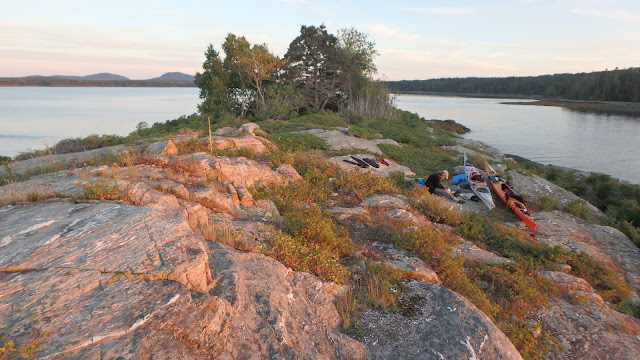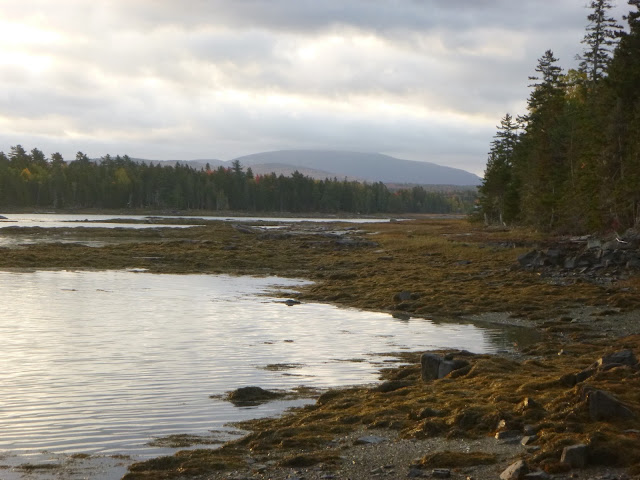If you're just tuning-in, this post covers the last couple of days of a two-month meander along the Maine Coast.
After the last blog post, we paddled the last forty nautical
miles, from Frenchman Bay to Stonington, to finish the trip in two more days.
We still needed to stop in Bar Harbor for some groceries and one last water
fill-up, so we followed the Porcupine Islands in, stopping first for a quick
break on The Hop. The fog had just cleared and the sun shone through- a good
day to see the mountains of Mount Desert Island rising before us, welcoming us
back to our neighborhood.
The seas were still pretty lively though, and we paddled
into a strong west wind. A big cruise ship lay at anchor in the near harbor,
while an odd private ship dominated the water southeast of Bar Island.
It carried a full-size sailing yacht on one side, ready to be lowered to the water.
Later I learned that it belongs to a Russian oil guy – the word ‘oligarch’ is
tossed around to describe him and his 90+ million-dollar toy, that also carries
a large motor yacht on its stern deck, and a helicopter that transports a Range
Rover. Apparently the ship is still there, still the talk of the town.
Despite the strong winds in our face as we made our way from
one Porcupine Island to the next in the lumpy wind-against-current seas, we
encountered a guided kayak trip led by one of the guides I’d trained in June.
I’d already been thinking that if I were guiding, I’d be taking the more
sheltered paddle along shore to Compass Harbor, but I was not surprised. They
were flying along downwind, and when the guide said hello, he said they were
just going to “peek around this island up here,” as if I might have some
thoughts on his choices or the task he would now have of getting these people
back to the launch against the wind. Of course I did, but after nearly two
months of not guiding or teaching people, I just smiled, happy it wasn’t my job
that day.
Tourists stood on the town beach, doing what tourists on
beaches do: staring down at the wrack line, skipping stones and taking photos. One
man was so engrossed in his attempts to skip a stone that his rock nearly hit
me. We pulled our kayaks up and I went off to get water and groceries, plunged
briefly into Bar Harbor tourist chaos. Is it possible, that among all these clean,
teeming hordes in their new Bar Harbor
sweatshirts congregating on the sidewalks seeming to not know where to spend
their money next, that I felt a private smug satisfaction when they glanced at
me wide-eyed and quickly looked away- that I secretly reveled in my three weeks
with no shower grime and my sun and salt-streaked skin? It is possible. After
our mostly-alone Downeast sojourn, this was a new, but not unexpected
sensation; not really where I wanted to be, but a sensation just the same.
We ate our customary pint of gelato on the beach and
continued on our way around the north side of MDI, eventually re-encountering
that strong west wind and a current that, thanks to our taking too long in Bar
Harbor, had turned against us. We ate lunch on Thomas Island and continued-on
beneath the bridge, where slow-moving traffic was backed-up for some distance. That
last stretch, with our campsite more or less in view, was a slow slog.
Which was why it was so great to arrive at our last campsite
of the trip, a tiny state-owned island called The Hub, and get our camp set-up
one last time. We arrived at low tide, and began the work of carrying our gear
and boats up the steep rocky ledges. But we’d spent all this time getting
better at it, and knowing this would be the last such carry of this trip,
performed the task with momentous care. Yes, we wanted to get through this and
finish the trip, but we also wanted to hang-on to the moment as much as we
could. Though the sun had been gradually setting earlier each night, it had
begun to feel like things were speeding-up, the days growing quickly shorter,
and we knew that time would pass and this would soon be a vague memory. We
stayed out on the ledges well after dark, watching for shooting stars and
satellites, and finally, reluctantly, called it a night.
We decided to end the trip at Old Quarry and we spent that
last day paddling, still mostly against the wind, down Blue Hill Bay to Naskeag Point,
our route now overlapping with the previous segments of the trip as we followed
Stinson Neck out to the Lazyguts and across to Sheep Island. With only a mile
and a half left, we took a break on Little Sheep, an island we’ve visited many
times, usually on the short guided‘family’ trips with kids. The day had begun hot –
one of the hottest so far, but the sun had sunk low enough that with the wind I
began to feel a hypothermic chill, and I added a layer for the final stretch.
We arrived at Old Quarry on one of their busiest days of the
summer. The area above the ramp was a solid mass of uncleaned boats. Much of
the staff had just left, returning to college, and the remaining crew had been
multi-tasking all day. We learned that our small travel trailer, which we’d
loaned for the summer, was vacant, so we carried our gear up to it. I checked
my messages and found one from Vicki, who offered a ride to our car after she
was done at the library. I called her and heard the background hub-bub of a
post poetry reading crowd, and she told me she could pick me up as soon as the
crowd left. I felt like I knew the quality of that background chatter well –
the same chit-chat from a dozen years of art gallery events, with many of the
same people. And I knew that a whole new challenge awaited us, that of
returning to something akin to a ‘normal’ life after living this parallel
fantasy out among the islands. It would not be easy, but that’s a story for
another time.
Notes:
Much of the area we paddled in this stretch is covered in
trips #8,9, 12, 13 & 14 in my guidebook AMC’sBest Sea Kayaking in New England.
I have a short article in the September/October issue of AMC Outdoors. It's about my first Instagram post while camping on an island, this spring, and the mixed feelings I had about it. Of course, since then, I've been posting quite a few photos on Instagram, as an easy way of letting friends know we haven't dropped off the map.
We’re now in Stonington at Old Quarry Ocean Adventures for maybe the next month or so. Stop by, say hi.
As we go through photographs from the trip, we'll be adding more to previous posts.





















































